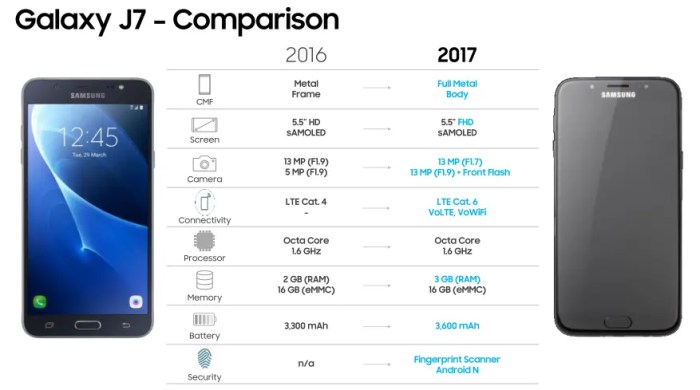Samsung Galaxy J7 Specification Details
Samsung Galaxy J7: A Mid-Range Contender: Samsung Galaxy J7 Specification

Source: gadgetstouse.com
Samsung galaxy j7 specification – The Samsung Galaxy J7 series occupied a significant space in the mid-range smartphone market during its lifespan. Known for offering a balance of features and affordability, the J7 series catered to a broad audience seeking dependable performance without breaking the bank. This article delves into the specifications and features of various J7 models, providing a comprehensive overview of this popular Samsung lineup.
Introduction to Samsung Galaxy J7

Source: phonesdata.com
The Samsung Galaxy J7 series debuted as a mid-range offering, aiming to provide users with a balance of features and affordability. The series saw several iterations over the years, each with incremental improvements in processing power, camera capabilities, and display technology. Key model variations include the J7, J7 Prime, J7 Pro, and J7 Max, released between 2015 and 2018.
The target audience for the Galaxy J7 was largely young adults and budget-conscious consumers who desired a reliable smartphone with decent performance and multimedia capabilities.
Display Specifications
The Samsung Galaxy J7 series featured a range of display sizes and technologies. While some models utilized Super AMOLED screens, others employed LCD technology. Brightness, contrast ratio, and color accuracy varied across models and generations. Generally, the displays provided satisfactory viewing experiences for everyday use, though they didn’t match the vibrant colors and higher resolutions found in higher-end smartphones at the time.
| Model | Screen Size | Resolution | Technology |
|---|---|---|---|
| J7 (2015) | 5.5 inches | 720 x 1280 pixels | Super AMOLED |
| J7 Prime | 5.5 inches | 1080 x 1920 pixels | Super AMOLED |
Compared to competitors like the Moto G series or the Xiaomi Redmi series, the J7 offered comparable display quality in its price range, with some models boasting higher resolutions than their counterparts.
Performance and Hardware
The Samsung Galaxy J7 series utilized various processors and RAM configurations depending on the specific model and release year. Internal storage options also varied, with the ability to expand storage via microSD card. Performance was generally adequate for everyday tasks, although heavy gaming or multitasking could sometimes lead to slight lag.
- J7 (2015): Exynos 7580 Octa-core processor, Mali-T720 GPU
- J7 Prime: Exynos 7870 Octa-core processor, Mali-T830 MP1 GPU
| Model | RAM | Internal Storage | Expandable Storage |
|---|---|---|---|
| J7 (2015) | 1.5GB/2GB | 16GB | Yes, via microSD |
| J7 Prime | 3GB | 32GB | Yes, via microSD |
Camera Capabilities
The camera specifications of the Samsung Galaxy J7 models varied across the series. Generally, the rear cameras offered decent image quality in good lighting conditions, while low-light performance was a common weakness. Front cameras were adequate for selfies and video calls.
- J7 (2015) Rear Camera: 13MP, f/1.9 aperture, autofocus, LED flash, 1080p video recording. Images showed good detail in bright light but lacked sharpness in low-light scenarios.
- J7 (2015) Front Camera: 5MP, f/1.9 aperture. Selfies were acceptable in well-lit environments.
Compared to competitors, the J7’s camera performance was generally on par with other mid-range offerings at the time. While it didn’t excel in low-light photography, it provided satisfactory results for everyday use.
Battery and Connectivity
The Samsung Galaxy J7 series featured varying battery capacities, providing decent battery life for typical usage. Charging technology was standard for the time. Connectivity options were comprehensive, including support for various cellular networks, Wi-Fi, and Bluetooth.
| Model | Battery Capacity (mAh) |
|---|---|
| J7 (2015) | 3000 |
Connectivity options typically included 4G LTE, Wi-Fi 802.11 b/g/n, Bluetooth 4.1, and GPS.
Software and User Interface, Samsung galaxy j7 specification
The Samsung Galaxy J7 series launched with various versions of Android, overlaid with Samsung’s custom TouchWiz user interface (later One UI). The UI provided various customization options and features specific to Samsung devices. Software updates were generally provided for a reasonable period, although the frequency and duration varied depending on the specific model and region.
Design and Build Quality
The Samsung Galaxy J7 models generally featured a plastic unibody construction, contributing to their affordability. The design was relatively simple and unassuming, prioritizing functionality over extravagant aesthetics. While not particularly premium in terms of materials, the build quality was generally solid and durable for everyday use. Dimensions and weight varied slightly between models.
The Samsung Galaxy J7 specification, while a solid offering for its time, lacked the advanced connectivity features found in newer models. For instance, consider the significant upgrade in connectivity offered by the Samsung Galaxy A15 5G, detailed in its specifications here. Returning to the J7, its strengths lay in its affordability and dependable performance, making it a popular choice for budget-conscious consumers.
Comparison with Other Models

Source: notebookcheck.net
The Samsung Galaxy J7 competed with various other mid-range smartphones during its release. Key differences often centered around processor performance, camera capabilities, and display technology. While the J7 offered a solid overall package, some competitors might have excelled in specific areas like camera quality or processing power.
| Feature | J7 | Competitor A (e.g., Moto G5 Plus) | Competitor B (e.g., Xiaomi Redmi Note 4) |
|---|---|---|---|
| Processor | Exynos 7870 (example) | Snapdragon 625 (example) | Snapdragon 625 (example) |
General Inquiries
Did the Samsung Galaxy J7 support expandable storage?
Yes, most J7 models supported expandable storage via microSD card.
What was the typical battery life of the Samsung Galaxy J7?
Battery life varied depending on usage, but generally offered a full day of moderate use.
Were there different screen sizes within the Samsung Galaxy J7 series?
Yes, the J7 series included models with varying screen sizes, typically ranging from 5.0 to 5.5 inches.
What operating systems did the Samsung Galaxy J7 run on?
The J7 series launched with various Android versions, depending on the model and release year, and received subsequent updates.





















